Year 5 - Fractions Learning Path (Green Profile)

Before starting this Learning Path
Before starting this Learning Path, the student should have a basic knowledge of Fractions and understand how to add and subtract equivalent fractions.
Learning Outcomes
- Compare and order fractions
- Identify, name and write equivalent fractions of a given fraction, represented visually, including tenths and hundredths
- Use common factors to simplify fractions; use common multiples to express fractions in the same denomination
- Add and subtract fractions with different denominators and mixed numbers, using the concept of equivalent fractions
- Multiply simple pairs of proper fractions, writing the answer in its simplest form
- Divide proper fractions by whole numbers
- Associate a fraction with division and be able to divide simple fractions
General teaching tips:
Students with the Green Profile generally love participation in class so encourage them to teach you how to do the questions once they are more confident with the concept- Ensure their understanding by teaching slowly and methodically, breaking everything down into the smallest steps- Before moving onto the next step, ensure their understanding by giving them variations of the same questions to continuously test their understanding
Step 1:
Name: Equivalent fractions
Learning outcomes:
- Identify, name and write equivalent fractions of a given fraction including tenths and hundredths (ENCY5)
- Compare and order fractions whose denominators are all multiples of the same number (ENCY5)
Introduce concept
Set a rough, 10-minute timer for them to complete all the questions in the following worksheet. Expect the student to either try the first question slowly and not move on until they get it or rush through the sheet quickly, often making many mistakes along the way. To avoid this, go through the first couple of questions together if you find that the student is struggling. Once they are happy with the question, go through 2 more variations of the question together before letting them carry on by themselves. This worksheet is also a great chance for the students to practice their arithmetics.
Worksheet: Equivalent Fractions D 2
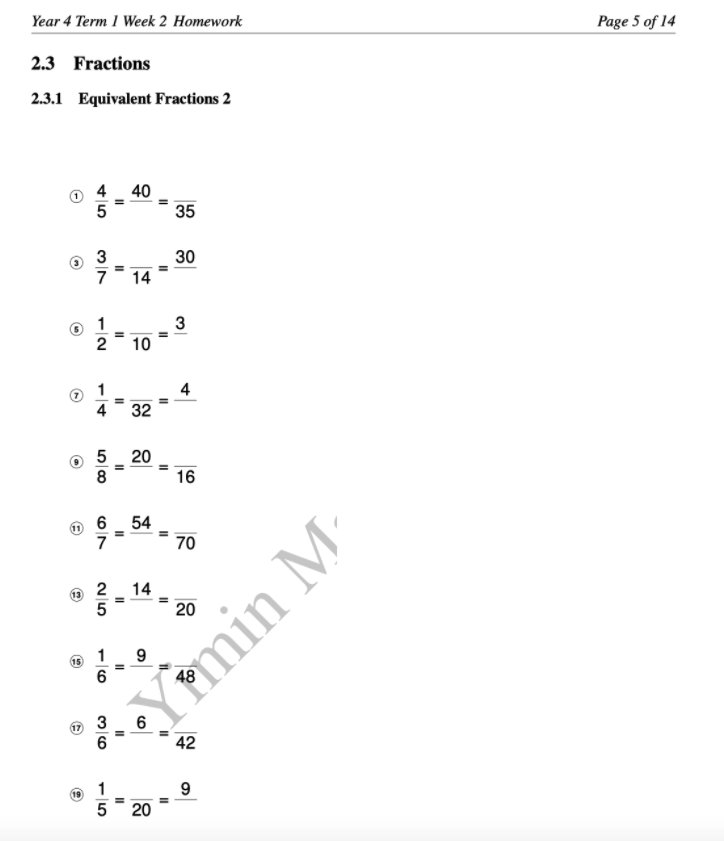
Step 2:
Extra practice
Students may need a little reminder on converting mixed fractions to improper fraction but otherwise should be able to complete this sheet on their own without any troubles. They may even complain that the sheet is too easy for them. As these students need to be taught methodically with the links between each concept made very clear to them, this worksheet will help them bridge the gap to non-equivalent fractions. Encourage them to continue on with the worksheet as they need to recap this step in order to better grasp and understand adding and subtracting with different denominators.
Worksheet: Add proper and mixed fractions D 1
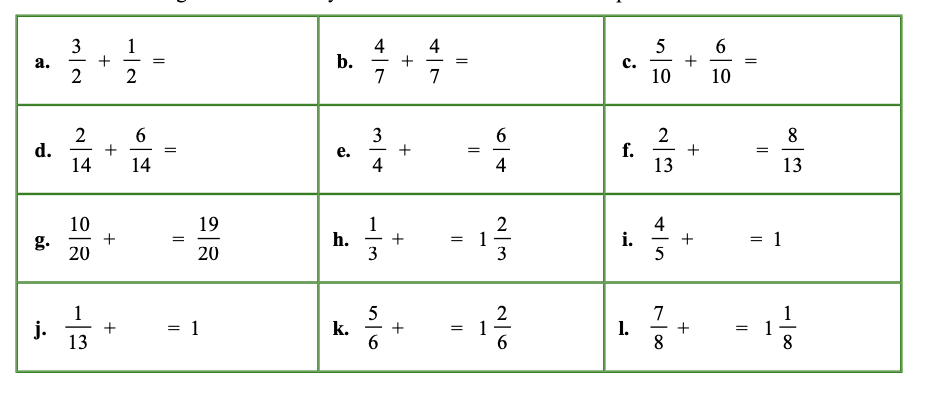
Step 3:
Name: Add/subtract proper fractions
Learning Outcomes:
- Identify, name and write equivalent fractions of a given fraction, represented visually (ENCY5)
- Add and subtract fractions with the same denominator and denominators that are multiples of the same number (ENCY5)
Introduce concept
These students love colouring in and being creative. Try using their favourite colour to make the worksheet fun and enjoyable for them! Conceptually make them understand what it means to add and subtract by colouring the fractions. To further their understanding, use different shapes, showing them variations on the same concept.
At the start, they might need a reminder of equivalent fractions. Use the first example to guide them and ask what number 3 and 2 go into. Once they understand that it is 6, ask them to convert 1/3 to something over 6 and 1/2 to something over 6. They should be able to do the rest of the question from there.
Worksheet: Add subtract unlike fractions V 1
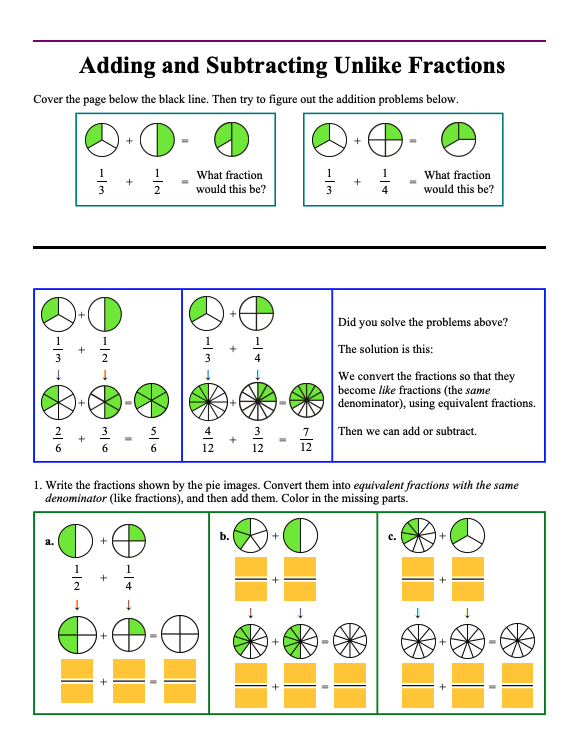
Step 4:
Extra practice
Expect students to initially try adding the denominators together. Help them conceptually understand the application of equating fractions using a real-life example. Try this example - if your mom had 2 cakes and she cut one cake into 3 slices and the other cake into 5 slices. If she gave your brother a piece from the cake with 3 slices and she gave you a piece from the cake with 5 slices, would you be happy? Once they understand the concept of equating fractions, give them another example to introduce adding unlike fractions. Try to get them to draw out adding 1/2 and 1/3 together. When they produce something that resembles 2/3s, explain that cutting them each so that the slices are of the same size will help them add them together more accurately. Expect these students to spend at least 30 minutes on these questions but they will especially love solving the codes and puzzles.
Worksheet: Add subtract unlike fractions V 2
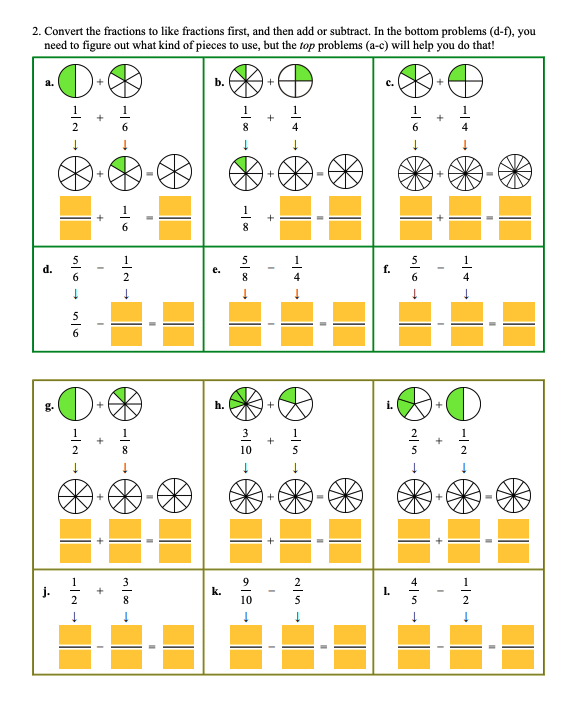
Step 5:
Introduce topic
Start by breaking down the whole number in the mixed fraction by the denominator of the fraction (so that 1 1/3 would be 3/3 +1/3). This will help them define what a mixed fraction is. They might struggle with the smaller fractions (1/8ths) where they will need extra encouragement and time with their arithmetics but will otherwise be able to complete this sheet on their own.
Step 6:
Introduce topic
When coming to mixed fractions, start out slow instead of introducing students to the shortcut of multiplying the whole number by the denominator and adding it to the numerator.Start by asking them how many thirds are in one whole, then ask them how many thirds are in two wholes. It helps if they draw it out. Using this, explain 1 1/3 by converting it to 3/3 + 1/3. This is also a good chance to test their arithmetics. If they are comfortable with their times tables, they can do this verbally instead. Once you are confident that they understand the notion of mixed fractions, you can introduce the shortcut of multiplying the whole number by the denominator and adding it to the numerator.
Step 7:
Name: Adding mixed fractions
Learning Outcomes:
- Recognise mixed numbers and improper fractions and convert from one form to the other and write mathematical statements > 1 as a mixed number (ENCY5)
- Add and subtract fractions with different denominators and mixed numbers, using the concept of equivalent fractions (ENCY6)
Introduce concept
Start by asking the student how they were taught to add mixed numbers in school. If they revert to converting the mixed numbers to improper numbers and then adding them, show these students that they can first add the whole numbers, then add the fractions together. For the more challenging questions (when the fraction components add up to become an improper fraction), prompt them to use what they have learnt in the previous step by asking them what they would do with an improper fraction.
Worksheet: Add mixed fractions V 1
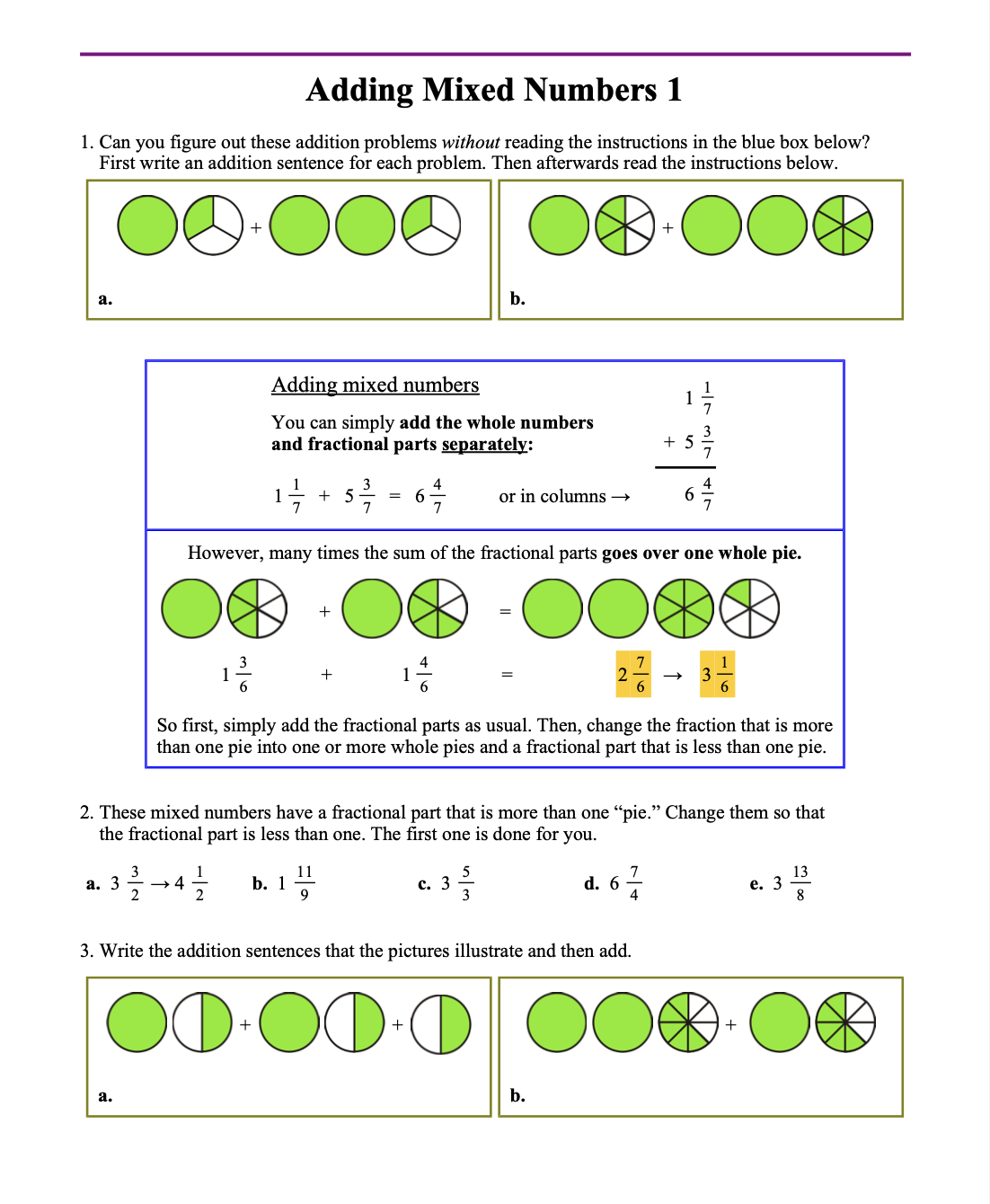
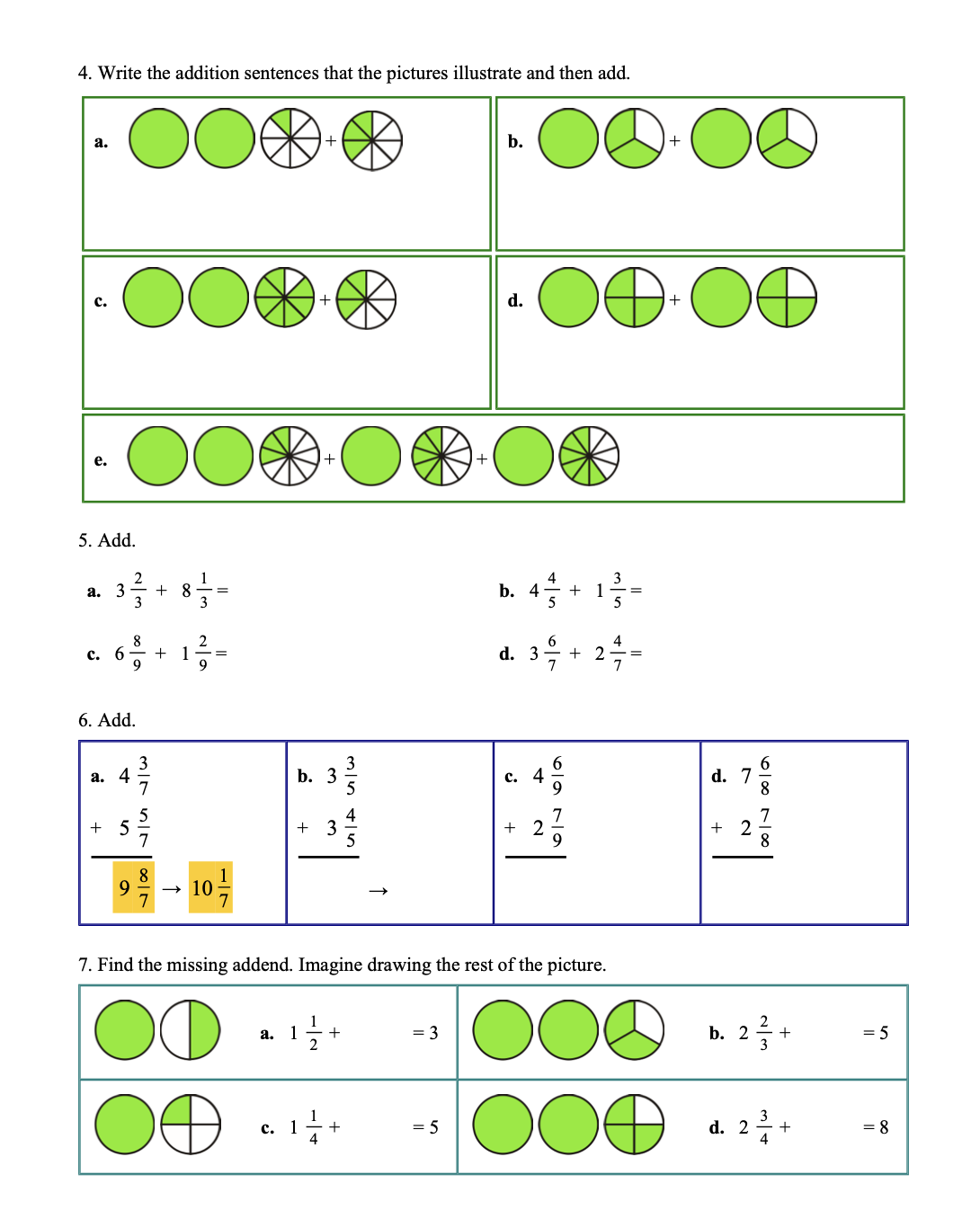
Step 8:
Extra practice
Start off with easier numbers so as to not confuse and discourage these students. They should be able to subtract simple mixed numbers with the same denominators easily, as long as they remember to subtract instead of adding them together
Worksheet: Subtract mixed fractions V 1


Step 9:
Recap
At this point, ask the student if they remember subtracting unlike fractions, if they are comfortable and can complete the first 3 questions with ease, move onto the next step. If not, spend 10 minutes on these questions as a recap, ensuring that they are familiar and comfortable with this before moving on.
Step 10:
Name: Adding mixed fractions
Learning Outcomes
- Recognise mixed numbers and improper fractions and convert from one form to the other and write mathematical statements > 1 as a mixed number (ENCY5)
- Add fractions with different denominators and mixed numbers, using the concept of equivalent fractions (ENCY6)
Introduce concept
Introduce the concept by asking students to shade in the shapes. Use the same method of subtracting the whole numbers and then subtracting the fraction. When the student asks what to do when the fraction you're subtracting is larger than the fraction you are subtracting by, prompt them to draw it out, convert the fractions to be the same denominator then shade out the areas that are subtracted.
Worksheet: Add mixed fractions V 2
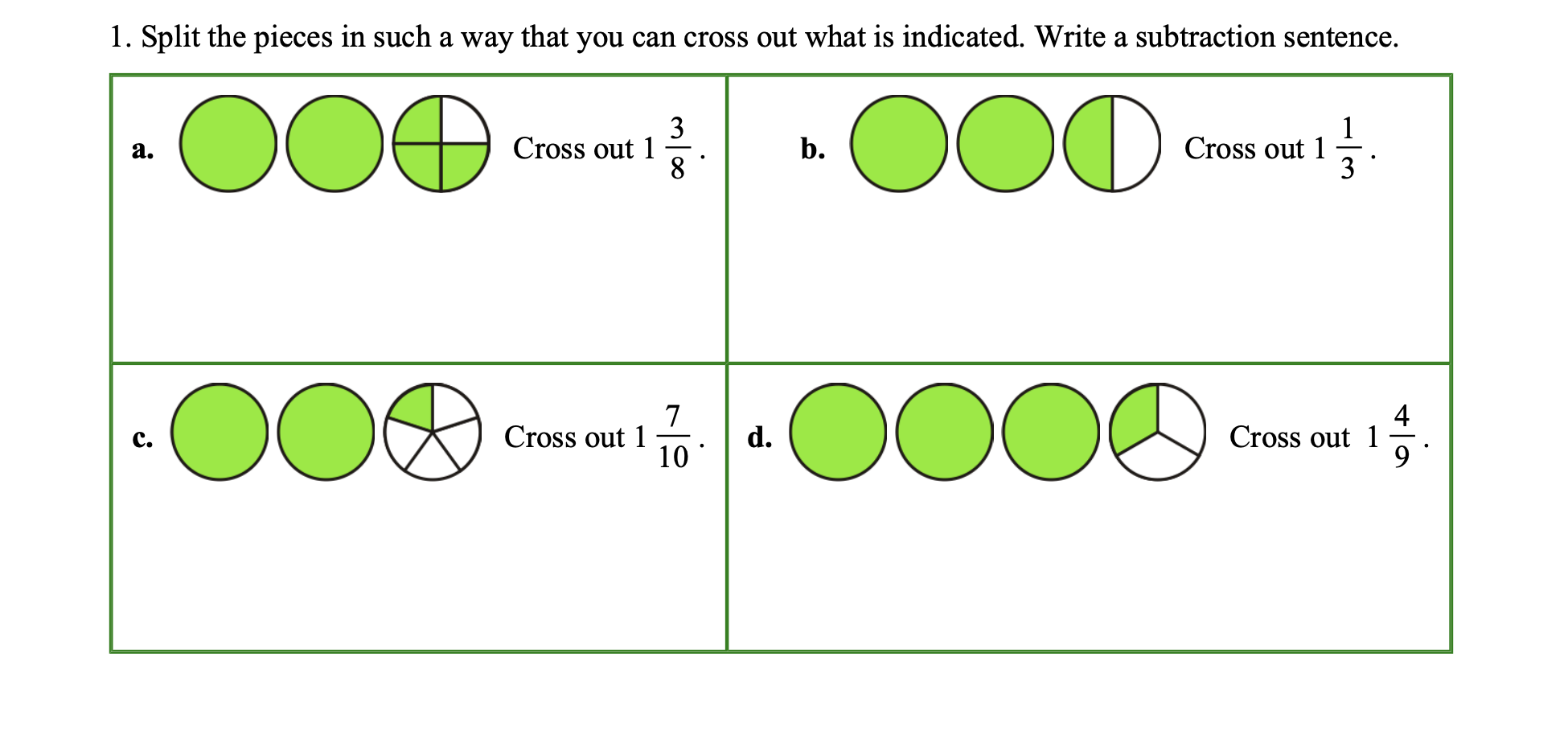
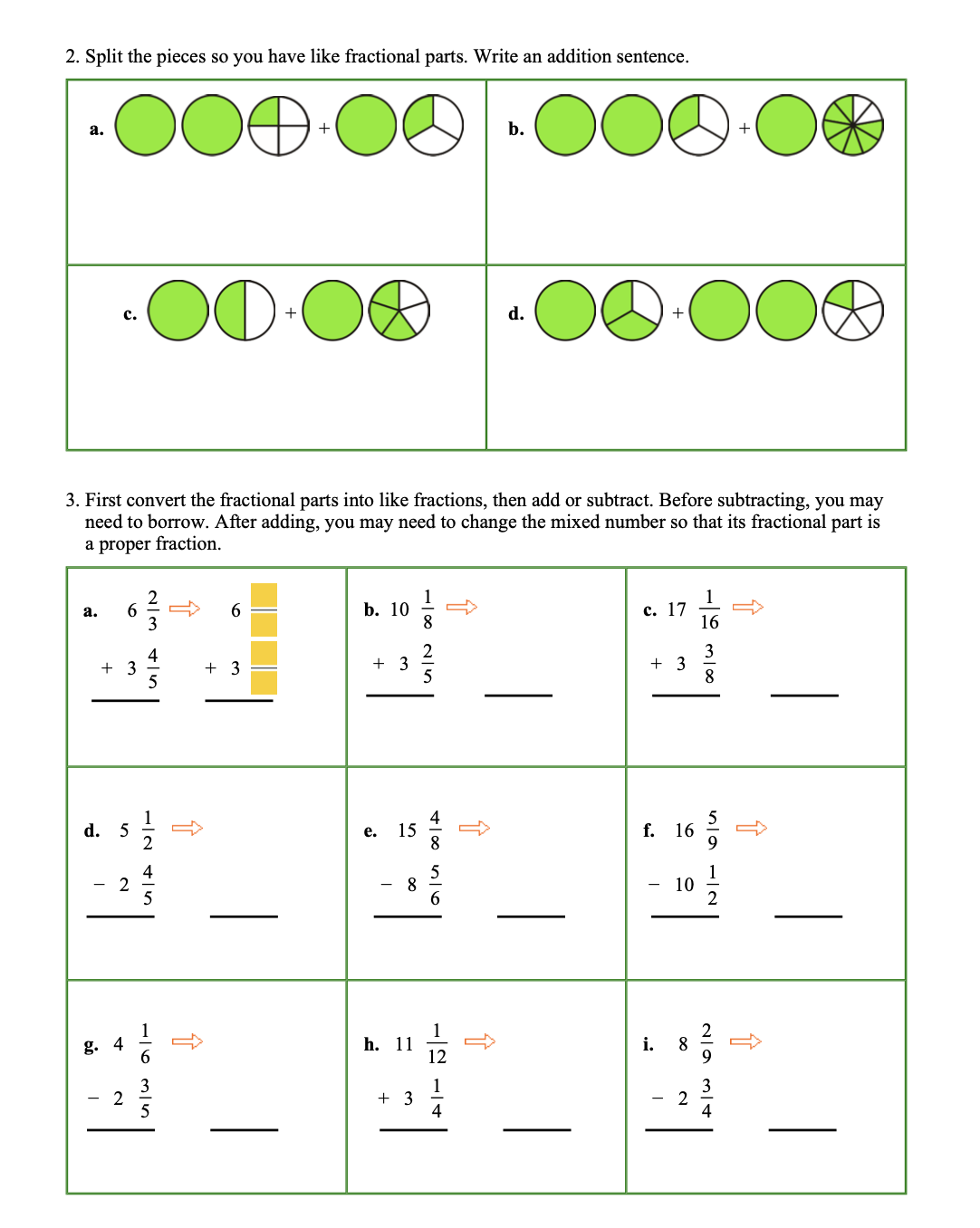
Step 11:
Name: Add/subtract mixed fractions
Learning Outcomes:
- Add and subtract fractions with the same denominator and denominators that are multiples of the same number (ENCY5)
- Add and subtract fractions with different denominators and mixed numbers, using the concept of equivalent fractions (ENCY6)
- Recognise mixed numbers and improper fractions and convert from one form to the other and write mathematical statements >1 as a mixed number (ENCY5)
Word problems
Reinforce their understanding while engaging them through puzzles and word problems! These students might gain more confidence and try to do things in their head, but encourage them to write it out on paper and give them the time and space to do so. When coming across the word problem, ask them to identify whether it is adding or subtracting first before continuing with the rest of the question.
Worksheet: Add subtract unlike fractions W 1
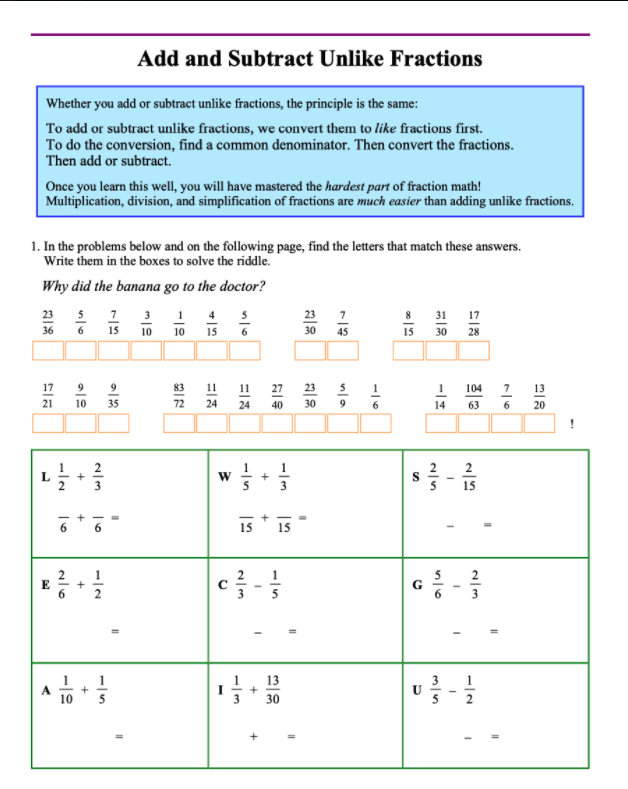
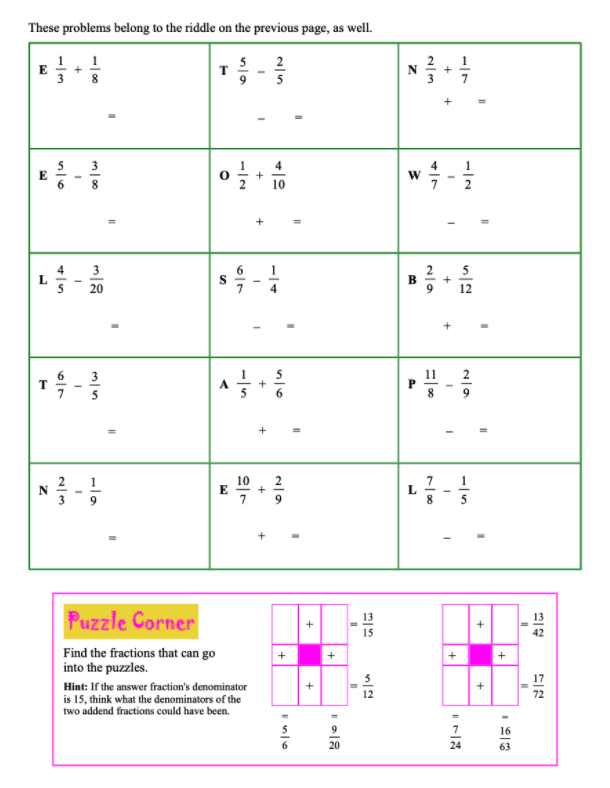

Step 12:
Introduce concept
When introducing multiplication, ask them what is half of a third of a cake. If this is too difficult, bring it down to what is half of 6. Help them understand that they are used to the concept of multiplying fractions because 6 is actually 6/1. Do variations of these questions until they are comfortable with the notion. Then explain that they just have to multiply the top numbers by the bottom numbers.
Step 13:
Name: Block method
Learning Outcomes:
- add and subtract fractions with different denominators and mixed numbers, using the concept of equivalent fractions (ENCY6)
- solve problems involving the relative sizes of two quantities where missing values can be found by using integer multiplication and division facts (ENCY6)
Introduce concept
Use this worksheet to explain how to use the Block Method to solve Fraction questions.
Worksheet: Block method fractions W 1


Step 14:
Introduce concept
Students with the Green Profile often struggle to remember to cross cancel before dividing and multiplying. Use this worksheet to ensure their understanding slowly and methodically so they remember each step of the method.